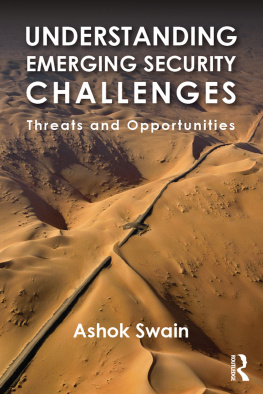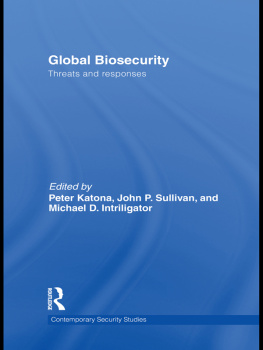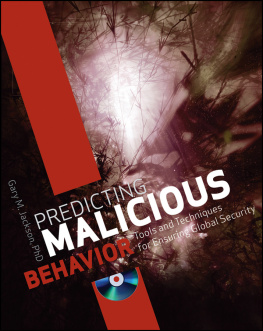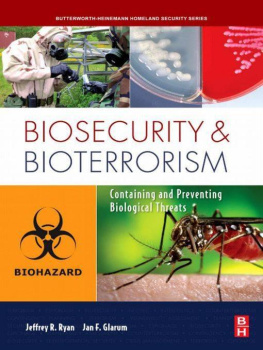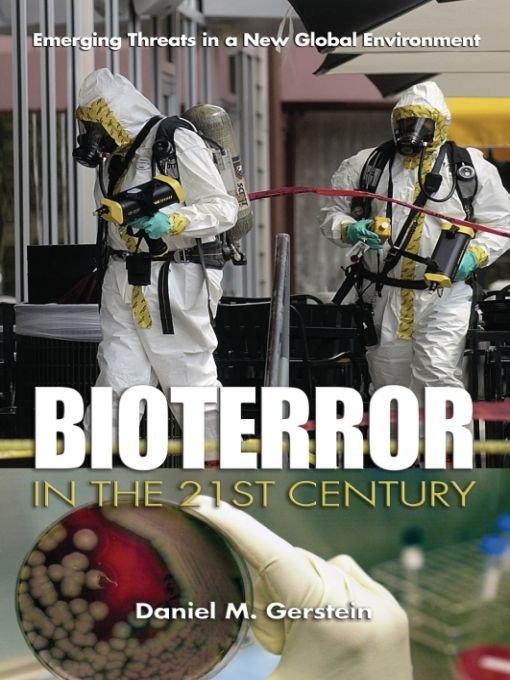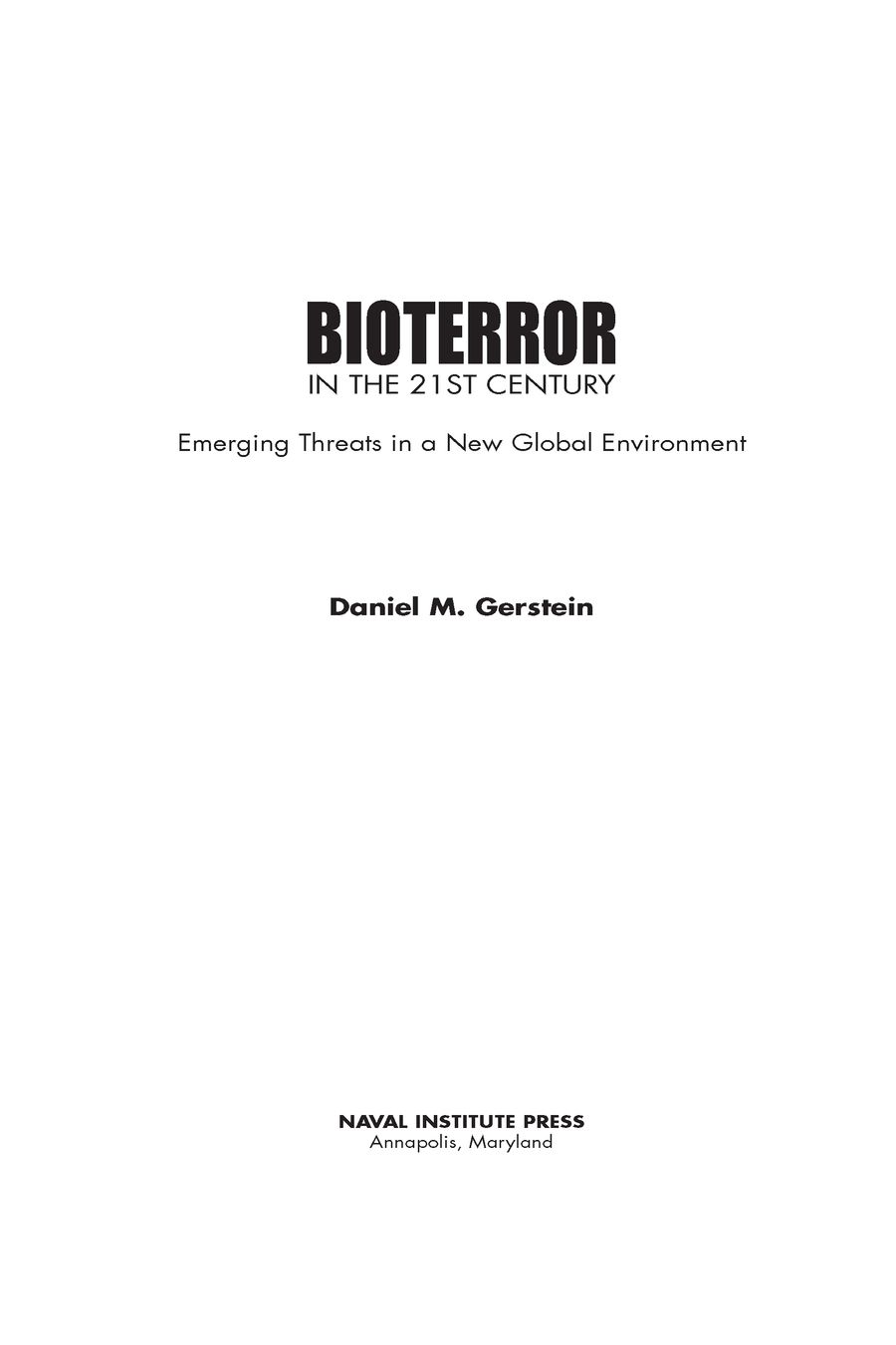Table of Contents
List of Tables
To my wife Kathy and
daughters Sarah and Rachel,
who never fail to inspire me and
cause me to want to do better.
Foreword
On September 11, 2001, America was attacked in a way few of us will forget. The images of the terrorist-controlled airplanes flying into buildings in New York and Washington, DC, and falling into a field in Pennsylvania left an indelible impression. We quickly discovered who the culprits were, took steps at airports and on airplanes to prevent a reoccurrence, and moved against the organization responsible.
A few weeks later, Americans were again the victim of an attack, but this time a biological weapon was hidden within the ubiquitous interchange of everyday mail. It took seven years for the Federal Bureau of Investigation (FBI) to publicly identify a suspect. While mail coming to government buildings in Washington is now treated, prevention on a larger scale is much more difficult.
The anthrax attack in the fall of 2001 has had far-ranging consequences in the efforts to protect Americans, and far-ranging consequences on the national psyche, but it may be just a foretaste of what is to come.
A host of studies and reports published before 9/11 warned of the potential use of nuclear, biological, or chemical weapons in the United States. While the destruction and consequences of a nuclear detonation would be in a category all its own, many who have studied the issues believe biological weapons pose the greatest danger.
Generally, biological weapons are easier to acquire than nuclear arms and can be lethal to an enormous number of people. They can hide among the population for a period, then spread widely as people and other carriers move about the country and even internationally, as the 2009 swine influenza has demonstrated, while health-care professionals attempt to diagnose the problem. Of course, the category biological weapons covers many different pathogens with a wide variety of characteristics, thus making prevention and preparation even more difficult.
Dr. Gerstein notes biological weapons stand at the intersection of two trends that provide tremendous benefits for humankind: (1) greater connectivity, which facilitates more communication and ease of movement, and (2) the biological revolution, in which new drugs and therapies are extending and improving life for millions. But he goes to the heart of the matter when he writes, The very capabilities that show such promise for increasing the longevity of humans and the quality of life of humankind have the potential to be combined in ways that could threaten and perhaps even doom the human race.
The challenge is to understand the threat we face, put it into perspective, and develop policies to deal with it appropriately. We should not overreact, which might divert our efforts from other threats that require our attention. We should plan and prepare, however, for the real possibilitymany would argue probabilitysuch weapons will be used against us again, and to far greater effect.
The pace of developments makes it difficult for policy makers and policy implementers to stay abreast of the threat. That is why Dr. Gersteins comprehensive but readable review of the subject is so welcome and so needed. It is a major contribution to an important subject that should spur sensible and thoughtful action.
CONGRESSMAN MAC THORNBERRY (R-TEX.)
Acknowledgments
No project of such magnitude could possibly be the work of a single person, and this one is no exception. This project began years ago with the many opportunities afforded to me to work on national security and defense issues. I will forever be indebted to my many mentors throughout almost three decades of professional assignments and educational opportunities in this field. The list includes soldiers, U.S. government civilians, educators, and policy experts who took time to teach me how to think, and not what to think. In this way, they contributed in untold ways to the completion of this effort.
This book began as a dissertation. I would like to specifically thank the members of my committee for the wisdom and insights they have provided to the effort. My committee chair, Dr. Reuben Brigety II, provided great insight into asking the right questions and pushing me to take a systems approach to this complex issue. Dr. Gregory Koblentz assisted me in the early stages of development of the topic and in the difficult policy questions associated with bioterror. Dr. Robert Baker was instrumental in teaching me the science behind biological warfare, as well as in providing me with a practical understanding of the nexus between biotechnology and bioterror. Dr. Ivan Sascha Sheehan guided my efforts to deal with the question of terrorismspecifically bioterror. In particular, Dr. Sheehan guided my understanding of the psychological aspects that motivate these individuals and groups. Ms. Kay Goss was instrumental in providing insights into the homeland security doctrine in the United States, and in how that doctrine would be used in the event of a bioterror event.
I would also like to thank my acquisitions editor at the Naval Institute Press, Adam Kane, who provided the direction for converting a dissertation into a book. This is no small task, and his dedication and perseverance helped to make the final product more relevant and readable.
I would also like to thank a number of friends and colleagues who have suffered through my musings and questions during the course of this project. Col. Chris Shoemaker, USA (Ret.), assisted greatly through one difficult period. Several colleagues have also been involved in discussions about the study methodology and in the reading of drafts. Their suggestions have immeasurably improved the final product. In this regard, I would like to thank Larry Loveless, Andrew Fulton, Lara Henry, and Dr. Jonathan Chanis.
Several individuals from within the biodefense community have also assisted greatly in this work. In particular, I would like to thank William C. Patrick III and Joel McCleary. Several others have been instrumental, but they wish to remain anonymous.
INTRODUCTION
Into the Abyss
The gravest danger our Nation faces lies at the crossroads of radicalism and technology. Our enemies have openly declared that they are seeking weapons of mass destruction, and evidence indicates that they are doing so with determination. The United States will not allow these efforts to succeed.
White House, National Security Strategy of the United States, September 17, 2006
Much has been written about the potential for a bioterror attack. Since the 2001 anthrax attacks in the United States, the lore surrounding the potential for a catastrophic and deadly bioterror attack has become an integral part of the future national security landscape. As we consider the potential for such an attack, several questions come to mind: Where would terrorists obtain the biological material for use in an attack? Would they be able to process the material in a meaningful way so it could be dispensed effectively and efficiently? Do biological weapons have the significant capability often attributed to them? Would there be any signs either during the weapons development or during dispersal that we could target? Do we have the necessary response capability? Finally, would we be ready? The following fictional scenario will begin to frame some of these difficult questions:



